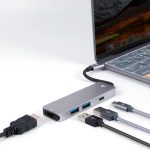When choosing between powered and unpowered USB hubs, consider your needs. Powered hubs come with an external power supply, making them ideal for high-demand devices like printers or external hard drives. They prevent connection drops and offer more ports. Unpowered hubs draw power from your computer's USB port, perfect for low-power devices like keyboards or mice. They're compact and portable, but can struggle with multiple devices. Keep exploring to find out which hub suits you best!
Table of Contents
Key Takeaways
- Powered USB hubs supply external power, making them suitable for high-demand devices like external hard drives and printers.
- Unpowered USB hubs draw power from the computer's USB port, ideal for low-power devices like keyboards and mice.
- Powered hubs typically offer more ports, allowing simultaneous connections without overloading the system.
- Unpowered hubs are compact and portable, making them a cost-effective choice for basic connectivity needs.
- Powered hubs enhance data transfer rates and reduce disconnections by maintaining stable power levels.
Understanding Powered USB Hubs
When it comes to USB hubs, understanding powered USB hubs is crucial for maximizing your device connectivity.
Powered USB hubs come with their own power supply, allowing them to deliver more power to connected devices. This means you can charge multiple devices simultaneously without draining your computer's resources.
Powered USB hubs provide their own power supply, enabling efficient charging of multiple devices without straining your computer.
They're ideal for high-demand peripherals like external hard drives, printers, and scanners, ensuring they function efficiently. With a powered hub, you won't have to worry about overloading your system or experiencing connection drops.
When you use a powered hub, you'll find that your devices respond faster and more reliably.
Understanding Unpowered USB Hubs
Although powered USB hubs are great for high-demand devices, unpowered USB hubs can still serve your everyday connectivity needs. These hubs draw power directly from your computer's USB port, making them compact and portable.
You'll find them perfect for connecting low-power devices like keyboards, mice, and flash drives. With typically four to seven ports available, unpowered hubs let you expand your connectivity without needing an external power source.
However, keep in mind that they share the power available from your computer, which can lead to performance issues if you connect multiple devices simultaneously.
If you primarily use low-energy peripherals, an unpowered USB hub can be a cost-effective and efficient solution for your basic connectivity requirements.
Key Advantages of Powered USB Hubs
Powered USB hubs offer several key advantages that make them an essential choice for anyone needing reliable connectivity.
First, they provide additional power through an external adapter, allowing you to connect multiple devices without worrying about power limitations. This is especially crucial when using power-hungry devices like external hard drives or printers.
Second, powered hubs can enhance data transfer rates, ensuring your devices communicate efficiently. You'll also experience fewer disconnections, as they maintain stable power levels.
Moreover, they often come with more ports, enabling you to connect various peripherals simultaneously.
Finally, they're perfect for setups that require power distribution, making them ideal for workstations or entertainment systems where multiple devices are in use.
Key Advantages of Unpowered USB Hubs
Unpowered USB hubs are a practical solution for users who need simple and efficient connectivity without the added complexity of external power sources.
You'll find these hubs incredibly handy for various situations, especially when you're on the go or working in tight spaces.
Here are some key advantages:
- Portability: Lightweight and compact, making them easy to carry.
- Simplicity: Just plug and play; no need for extra cables or power adapters.
- Cost-Effective: Generally cheaper than powered alternatives, perfect for budget-conscious users.
- Low Power Consumption: These hubs draw power directly from your devices, reducing energy use.
With these benefits, unpowered USB hubs cater to your basic connectivity needs efficiently and conveniently.
Choosing the Right USB Hub for Your Needs
When selecting the right USB hub, consider your specific needs and how you plan to use it.
Consider your needs and usage when choosing the right USB hub for optimal performance.
If you're connecting multiple devices, a powered USB hub might be your best bet, as it provides extra power for high-demand peripherals like external hard drives and printers.
On the other hand, if you need a hub for simple tasks like connecting a keyboard or mouse, an unpowered hub should suffice.
Think about portability too; if you travel frequently, a compact, lightweight hub will be more convenient.
Finally, check the number of ports you need and any additional features, like fast charging or data transfer speeds, to ensure the hub meets all your requirements.
Choose wisely to enhance your tech experience!
Frequently Asked Questions
Can I Use a Powered Hub With Unpowered Devices?
Yes, you can use a powered hub with unpowered devices. The hub provides additional power, ensuring your devices function properly. Just plug them in, and you'll enjoy enhanced performance without worrying about power limitations.
Do Unpowered Hubs Affect Device Charging Speed?
Unpowered hubs can limit charging speed since they draw power from your devices. If you connect multiple devices, they may not charge efficiently, often resulting in slower charging times compared to using a powered hub.
Are There Any Compatibility Issues Between Hubs and Devices?
You might encounter compatibility issues between hubs and devices, especially with older models or unique specifications. Always check device requirements and hub specifications to ensure everything works seamlessly together, preventing frustrating connectivity problems.
How Many Devices Can I Connect to a USB Hub?
You can connect multiple devices to a USB hub, typically ranging from four to ten, depending on the hub's design. Just ensure your computer supports the number of connections you plan to use simultaneously.
What Materials Are Commonly Used in USB Hub Construction?
USB hubs typically use materials like plastic for the casing, copper for wiring, and sometimes aluminum for better heat dissipation. These materials ensure durability and efficient data transfer while keeping your devices connected seamlessly.




